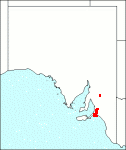Family: Asteraceae
Helichrysum rutidolepis
Citation:
DC., Prod. 6:194 (1838).
Synonymy: Not Applicable Common name: Pale everlasting.
Description:
Stoloniferous perennial herb 15-40 cm tall and up to 1 m diam.; stems several, much-branched, the branches for much of their length prostrate, finally ascending, with a sparse to moderately dense more or less close vestiture of longitudinally arranged woolly-cobwebby hairs and minute sessile glandular hairs; leaves broadly linear to linear, sometimes narrowly oblanceolate, with narrowly recurved margins, apiculate apex and narrowly cuneate more or less stem-clasping base, mostly 2.5-8 cm long, 1.5-8 mm wide, gradually decreasing in size up the stem, discolorous, with a close vestiture of woolly-cobwebby hairs and minute glandular hairs, sparse on the upper side, moderately dense on the underside.
Capitula solitary, terminal on long branches bearing distally reduced leaves, broadly campanulate (the laminae of the bracts more or less patent at flowering), 0.6-1 cm long when pressed (including the laminae), eventually 1.5-2 cm diam.; involucral bracts 6-8-seriate, the intermediate ones longest; outermost bracts wholly scarious, opaque, stramineous, enveloped in dense wool; intermediate bracts wholly scarious or contracted into broadly linear stramineous firm dry claws, 5-7 mm in total length and equal to or just exceeding the florets which are exserted when the laminae are patent, shining, golden-brown to deep-yellow; florets numerous, the outer female ones with very prominent brown styles; style branches truncate, long-papillose.
Achenes oblong-fusiform, slightly compressed, somewhat angular, brown, glabrous; pappus bristles not or scarcely connate, for most of their length white and barbellate, at the apex pale-yellow with a few long barbs, of the bisexual florets 15-20, of the female florets very rudimentary or lacking.
Published illustration:
Cunningham et al. (1982) Plants of western New South Wales, p. 702.
|
|
Distribution:
|
In this State rare, usually along watercourses in grassy understorey of Eucalyptus camaldulensis woodland.
N.S.W.; Vic.
|
Conservation status:
native
Flowering time: Jan. — March, July.
|

SA Distribution Map based
on current data relating to
specimens held in the
State Herbarium of South Australia
|
Biology:
Closely resembles the late-spring-flowering H. scorpioides but with smaller capitula, paler outer involucre and lacking the coarse septate glandular hairs on the upper side of the more pronouncedly oblanceolate leaves of that species.
Author:
Not yet available
|

